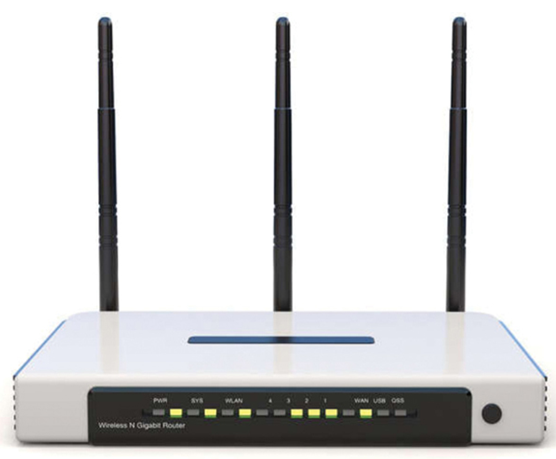Regardless of whether the fault is present on the wireless or wired network, one of the first steps in a bottom-up strategy of troubleshooting should be to examine the LEDs, which indicate the current state or activity of a piece of equipment or connection. LEDs may change color or flash to convey information. The exact configuration and meaning of LEDs varies between manufacturers and devices. Figure 36-5 shows a typical wireless router with LEDs indicating power, system, WLAN, wired ports, and Internet (labeled WAN in Figure 36-5), USB, and Quick Security Setup (QSS, also known as Wi-Fi Protected Setup [WPS]).
Note
WPS/QSS has known vulnerabilities that allow a threat actor to gain access to your network. Therefore, it is a security best practice to disable this feature. Refer to documentation to learn how to disable WPS or QSS.

Figure 36-5 LED Lights on a Wireless Router
On some devices, a single LED may convey multiple pieces of information depending on the current status of the device. It is important to check the equipment documentation for the exact meaning of all indicators, but some commonality does exist.
Most devices will have activity LEDs, which are often called link lights. A normal condition is for these LEDs to flash, indicating that traffic is flowing through the port. A solid green light typically indicates that a device is plugged into the port, but no traffic is flowing. No light typically indicates one or more of the following:
- Nothing is plugged into the port.
- There is an issue with the wired or wireless connection.
- A device or port has failed.
- There is a cabling issue.
- The wireless router is improperly configured; for example, a port was administratively shut down.
- The wireless router has a hardware fault.
- The device does not have power.
Whether the network is wired or wireless, verify that the device and ports are up and functional before spending large amounts of time trying to troubleshoot other issues.
If the wired client is unable to connect to the wireless router, one of the first things to check is the physical connectivity and cabling. Cabling is the central nervous system of wired networks and one of the most common issues when experiencing inactivity.
There are several issues to watch for when cabling:
• Be sure to use the correct type of cable. Two types of UTP cables are commonly encountered in networking: straight-through cables and crossover cables. Using the wrong type of cable may prevent connectivity.
• Improper cable termination is one of the main problems encountered in networks. To avoid this, cables should be terminated according to standards. Terminate cables via the T568A or the T568B termination standard. Avoid untwisting too much of the wire pairs during termination. Crimp connectors on the cable jacket to provide strain relief.
• Maximum cable run lengths exist based on characteristics of the different cables. Exceeding these run lengths can have a serious negative impact on network performance.
• If connectivity is a problem, verify that the correct ports are being used between the networking devices.
• Protect cables and connectors from physical damage. Support cables to prevent strain on connectors and run cable through areas that will not be in the way.
Check Your Understanding—Physical Layer Problems (36.2.4)
Refer to the online course to complete this activity.
